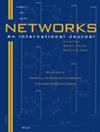解决由组合特性驱动的路由和频谱分配问题
IF 1.3
4区 计算机科学
Q4 COMPUTER SCIENCE, HARDWARE & ARCHITECTURE
引用次数: 0
摘要
现代光网络中的路由和频谱分配问题是近年来受到越来越多关注的NP-hard问题。针对该问题的大多数现有整数线性规划模型使用边路径公式,其中变量与所有可能的路由路径相关联,因此变量的数量随着实例的大小呈指数增长。为了绕过这个困难,通常使用每个需求的所有可能路径的预先计算子集,这通常不能保证解决方案的最优性。我们的贡献是为边缘路径公式的使用提供了一个框架,以最小化解决方案的频谱宽度。为此,我们选择一个合适的路径子集,利用组合属性对其进行操作,从而保证解的最优性。计算结果表明,我们的方法确实有希望解决路由和频谱分配问题。本文章由计算机程序翻译,如有差异,请以英文原文为准。
Solving the routing and spectrum assignment problem, driven by combinatorial properties
The routing and spectrum assignment problem in modern optical networks is an NP-hard problem that has received increasing attention during the last years. The majority of existing integer linear programming models for the problem uses edge-path formulations where variables are associated with all possible routing paths so that the number of variables grows exponentially with the size of the instance. To bypass this difficulty, precomputed subsets of all possible paths per demand are typically used, which cannot guarantee optimality of the solutions in general. Our contribution is to provide a framework for the use of edge-path formulations to minimize the spectrum width of a solution. For that, we select an appropriate subset of paths to operate on with the help of combinatorial properties in such a way that optimality of the solution can be guaranteed. Computational results indicate that our approach is indeed promising to solve the routing and spectrum assignment problem.
求助全文
通过发布文献求助,成功后即可免费获取论文全文。
去求助
来源期刊

Networks
工程技术-计算机:硬件
CiteScore
4.40
自引率
9.50%
发文量
46
审稿时长
12 months
期刊介绍:
Network problems are pervasive in our modern technological society, as witnessed by our reliance on physical networks that provide power, communication, and transportation. As well, a number of processes can be modeled using logical networks, as in the scheduling of interdependent tasks, the dating of archaeological artifacts, or the compilation of subroutines comprising a large computer program. Networks provide a common framework for posing and studying problems that often have wider applicability than their originating context.
The goal of this journal is to provide a central forum for the distribution of timely information about network problems, their design and mathematical analysis, as well as efficient algorithms for carrying out optimization on networks. The nonstandard modeling of diverse processes using networks and network concepts is also of interest. Consequently, the disciplines that are useful in studying networks are varied, including applied mathematics, operations research, computer science, discrete mathematics, and economics.
Networks publishes material on the analytic modeling of problems using networks, the mathematical analysis of network problems, the design of computationally efficient network algorithms, and innovative case studies of successful network applications. We do not typically publish works that fall in the realm of pure graph theory (without significant algorithmic and modeling contributions) or papers that deal with engineering aspects of network design. Since the audience for this journal is then necessarily broad, articles that impact multiple application areas or that creatively use new or existing methodologies are especially appropriate. We seek to publish original, well-written research papers that make a substantive contribution to the knowledge base. In addition, tutorial and survey articles are welcomed. All manuscripts are carefully refereed.
 求助内容:
求助内容: 应助结果提醒方式:
应助结果提醒方式:


